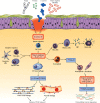Sinonasal Tissue Remodelling during Chronic Rhinosinusitis
- PMID: 34567126
- PMCID: PMC8460364
- DOI: 10.1155/2021/7428955
Sinonasal Tissue Remodelling during Chronic Rhinosinusitis
Abstract
The purpose of this review is to summarise contemporary knowledge of sinonasal tissue remodelling during chronic rhinosinusitis (CRS), a chronic disease involving long-term inflammation of the paranasal sinuses and nasal passage. The concept of tissue remodelling has significant clinical relevance because of its potential to cause irreversibility in chronic airway tissues. Recent studies have indicated that early surgical treatment of CRS may improve clinical outcome. Tissue remodelling has been described in the literature extensively with no consensus on how remodelling is defined. This review describes various factors implicated in establishing remodelling in sinonasal tissues with a special mention of asthma as a comorbid condition. Some of the main histological features of remodelling include basement membrane thickening and collagen modulation. This may be an avenue of research with regard to targeted therapy against remodelling in CRS.
Copyright © 2021 Satya Amirapu et al.
Conflict of interest statement
The authors declare that there are no conflicts of interest regarding the publication of this study.
Figures




References
-
- Fokkens W. J. Epos 2020. Official Journal of the European and International Rhinologic Societies and of the Confederation of European ORL-HNS. 2020;29:1–464.
-
- Hopkins C., Rimmer J., Lund V. J. Does time to endoscopic sinus surgery impact outcomes in chronic rhinosinusitis? Prospective findings from the national comparative audit of surgery for nasal polyposis and chronic rhinosinusitis. Rhinology Journal. 2015;53(1):10–17. doi: 10.4193/Rhin13-217. - DOI - PubMed
Publication types
LinkOut - more resources
Full Text Sources

